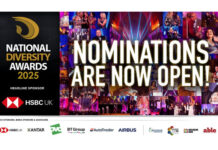In this week’s guest column, Cornerstone’s Chief People Officer Carina Cortez, shares a four-step plan on how to implement a results-driven diversity, equity, inclusion and belonging (DEIB) programme to boost inclusivity in your organisation.
DEIB has often come under hot debate and scrutiny in the public sphere, with some sharing concerns that it amounts to “reverse discrimination”, divisiveness and “groupthink” – a psychological phenomenon in where the desire for conformity in a group results in irrational or dysfunctional decision-making. We must take a stand against these concerns, and organisations can do so by putting in place a results-driven DEIB programme.
But how to do this? Last year, McKinsey found that whilst 70% of respondents said their organisations express transformative DEI aspirations; less than half had the infrastructure to actually realise these aspirations. Nevertheless, the appetite to improve is clearly there. Our latest research, found a 248% rise in efforts to enhance talent and workforce diversity, equity, and inclusion (DEI), globally, from 2019-2024. This upward trend underscores the importance of creating a supportive and inclusive work environment that values employee wellbeing and diversity.

There are several ways organisations can actively, and consciously, take steps to drive inclusivity. Below, I break down some clear, tangible actions for leaders to put into place.
1. Stand Up Employee Resource Groups (ERGs)
Many individuals from underrepresented groups face several unique, unspoken challenges at work. With inclusive ERGs, workers can have a safe space to hash out concerns or discuss taboo topics, opening the doors for hard conversations and in turn, making the hurdles more manageable; fostering a sense of inclusion and belonging.
2. Offer Mentorship of Sponsorship Programmes
Some individuals may be less comfortable touting their successes, causing their contributions to be overlooked in collaborative projects. In team meetings, group meetings or project meetings, mentors, and sponsors – created through specific programmes and organically – can step in to highlight and celebrate their colleagues’ wins. This activation will ensure efforts aren’t ignored, but instead, rightfully recognised.
3. Define Goals for Underrepresented Groups
With thoughtful hiring and inclusion goals, positive progress towards equity can be achieved. For example, organisations can define metrics around representation in leadership, creating programmes to achieve the goals and systems to track the progress year-over-year. This will help give those from marginalised groups a newfound power and confidence in the workforce.
4. Implement Agile Learning Opportunities for Career Growth
As where and how we work changes, employees desire flexibility and agility in the workplace. Implementing the tools and resources needed to learn new skills and strengthen existing skills whenever they desire can support dynamic, personalised career pathing and empower growth, no matter personal situations within or outside of the workplace.
To manage verbal harassment, companies must have the programmes and policies in place (i.e. ERGs, zero-tolerance harassment practices, anti-retaliation policies, minorities in decision making/leadership positions, ensuring HR team knows how to deal with such complaints, etc.) to ensure all employees, in this case are supported and have ways to escalate anything that may be occurring.
It’s crucial for organisations to double down on their commitment to creating a positive social impact in our current society. DEIB initiatives are integral to this. They are clearly becoming an increasingly important area of focus for employees and organisations worldwide. We must all make a conscious, concerted effort to learn, and to do better. Giving those from marginalised and minority groups the space and platforms for their voices to be heard, and for them to thrive, is how we move the needle in driving inclusivity in the workplace.







































